Belfast Blitz Plaques
Following the 75th Anniversary of the 1941 German air raids on Northern Ireland, Belfast City Council erected a number of memorial plaques at various locations in the city. The phrasing of the inscriptions on all but three of the plaques refers to “lives lost here” but it is unclear whether it refers literally to fatalities at the location/street, the number of people who lived in the location/street who died, the number of people from the area near the location who died, or a mixture of the circumstances.
 The Commonwealth War Graves Commission (CWGC) website includes a Civilian War Dead section which lists the place of death and the place of residence for fatalities, the information having been collated from the Civil Defence Authority fatality lists and other sources. The anomalies between the figures specified on the Belfast City Council plaques and the CWGC Civilian War Dead List (henceforth CWGC List) will be examined in this article.
The Commonwealth War Graves Commission (CWGC) website includes a Civilian War Dead section which lists the place of death and the place of residence for fatalities, the information having been collated from the Civil Defence Authority fatality lists and other sources. The anomalies between the figures specified on the Belfast City Council plaques and the CWGC Civilian War Dead List (henceforth CWGC List) will be examined in this article.
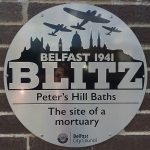 1 Temporary Mortuaries
1 Temporary Mortuaries
The first plaque was erected at St George’s Market, which was used as a temporary mortuary following the air raids and was the centralised location for the identification of bodies. On 21st April and 9th May, funeral corteges left St George’s Market, with unidentified and identified but unclaimed bodies being interred in publicly-owned plots in Belfast City Cemetery and Milltown Cemetery.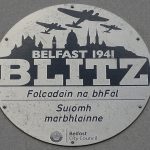
Plaques were also erected to mark the use of the Peter’s Hill Baths and the Falls Road Baths as temporary mortuaries, but no arrangements were made to erect a similar plaque at the temporary mortuary at Erskine’s Felt Works in Whitehouse.
2 Campbell College
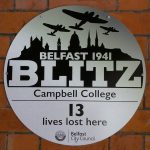 Campbell College was taken over by the military authorities as the 24th (London) General Hospital shortly after the start of the Second World War and was hit on the night of 4th/5th May 1941. The Blitz Victims List compiled by the Northern Ireland War Memorial records that 24 people died at the hospital, including one civilian fatality. Of the 23 army personnel killed, nine are buried in Northern Ireland and the remainder were repatriated to Great Britain for interment. The civilian was Mary Jane Close (58) who was injured at her home in Westbourne Street and died at the hospital and is buried in Dundonald Cemetery.
Campbell College was taken over by the military authorities as the 24th (London) General Hospital shortly after the start of the Second World War and was hit on the night of 4th/5th May 1941. The Blitz Victims List compiled by the Northern Ireland War Memorial records that 24 people died at the hospital, including one civilian fatality. Of the 23 army personnel killed, nine are buried in Northern Ireland and the remainder were repatriated to Great Britain for interment. The civilian was Mary Jane Close (58) who was injured at her home in Westbourne Street and died at the hospital and is buried in Dundonald Cemetery.

3 Pottinger – Ravenscroft Avenue
The CWGC List records Ravenscroft Avenue as the death location for only five people, including four members of the Frizzell family from Number 39 and Thomas Crone Bingham, a sixteen-year-old ARP volunteer from Isoline Street. However, a further sixteen people died in the Ravenscroft Avenue area. Fifteen lives were lost at Avondale Street, including six members of the McCullough family at Number 8. Another sixteen-year-old ARP volunteer, William James Mays from Lichfield Avenue, died at Rosebery Street. Consequently, the German bombing of the Ravencroft Avenue area resulted in the deaths of 21 people but only five died at Ravenscroft Avenue. Ravenscroft Public Elementary School was destroyed, and 47 houses were either destroyed or left uninhabitable.
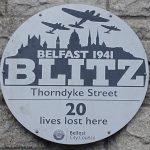 4 Mountpottinger – Thorndyke Street
4 Mountpottinger – Thorndyke Street
On the night of 15th/16th April, a 250kg bomb exploded near the air raid shelter, causing the walls to buckle and the concrete roof fell on the people inside. The CWGC List records that seventeen people died in Thorndyke Street, nine at the air raid shelter. Thirteen of the fatalities were residents of the street, including six members of the Wherry family from Number 16. Four of the Thorndyke Street fatalities resided elsewhere – ARP Warden Joseph Bell (45) of Lord Street, ARP Messenger Phares Hill Welsh (16) of Paxton Road, William Stewart (55) of Lord Street, and William Murray (30) of Cherryville Street. Another resident of Thorndyke Street, Sarah Hughes (62), died at the Royal Victoria Hospital and Andrew McAdams (75) died in nearby Dufferin Street. The bomb that exploded at Thorndyke Street resulted in the deaths of nineteen people.
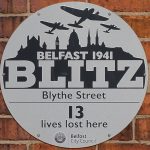 5 Sandy Row – Blythe Street
5 Sandy Row – Blythe Street
The only Blitz Plaque in South Belfast is attached to an outer wall of St Aidan’s Church of Ireland and records that thirteen lives were lost at Blythe Street, which matches the details on the CWGC List. Fourteen people who lived in Blythe Street died as a result of the air raid, including a father and daughter who were injured at Blythe Street, died at the Belfast Union Infirmary, and are buried in Ballynure Cemetery – Rebecca Craig (7) died on 16th April and Robert Craig (36) died two days later. Nine people died at 95 Blythe Street, the home of William and Jane McKee, who lost a son, two married daughters, and five grandchildren. David McKee (26) was an Engineer in the Merchant Navy and Sarah Jane (Sadie) Thompson (21) from 313 Donegall Road, was visiting the family when she died.
6 Yorkgate – Sussex Street and Vere Street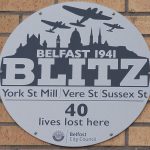
Although the York Street Flax Spinning Mill took a direct hit, no fatalities are recorded as dying at the mill. However, the falling masonry from the mill and other bombs brought death and destruction to the close-packed streets of housing between the mill and Gallaher’s tobacco factory at Earl Street. In 1939, there were 260 residential properties in the area but there were only 128 houses after 1941. In addition, York Street Presbyterian Church on the corner of Earl Street and York Street Non-Subscribing Presbyterian Church were destroyed. The CWGC List records that thirty-four people died in either Sussex Street or Vere Street, with twenty-nine being residents and the other five being from Pilot Street, New Lodge Road, Chatham Street, Artillery Street, or Orchard Street. Mary McSourley (12) of 74 Vere Street died at the Mater Hospital and the Civil Defence Authority’s 9th List (dated 21st April 1941) records Kathleen Malone of 31 Sussex Street as a fatality but she is not recorded on the CWGC list or on the NIWM Blitz Victims List. Lance Corporal John Thomas Park and Corporal David Cooper Simpson from 507th Field Company, Royal Engineers, died at the junction of Henry Street and North Queen Street during the May air raids. The death toll for the area was 38 and not 40 as recorded on the plaque.
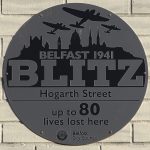 7 Tiger’s Bay – Hogarth Street
7 Tiger’s Bay – Hogarth Street
Unlike other locations where the Belfast City Council plaques specify exact numbers, the plaque at Hogarth Street records “up to 80 lives lost here”. The CWGC List records that 69 civilians died at Hogarth Street and nine died at Edlingham Street, including eight people from other streets. A memorial at Hogarth Street, since removed after being vandalised, recorded the names of 117 fatalities from the Tiger’s Bay area. The CWGC List records that 71 residents of Hogarth Street and Edlingham Street died, with six-year-old Jean Spratt dying of injuries at Belfast City Hospital. Six members of the Wilson family died at 56 Edlingham Street and five people living at 65 Hogarth Street died, including two women from Glasgow. Hugh Baxter McNeill had died on 3rd March 1941, aged 49, and his widow Annie Lorna McNeill (nee Dornan) died on the night of 15th/16th April at the age of 46, along with her children, Hetty (23) and Hugh Baxter McNeill (19). Also at the house were her mother and sister – Harriett Dornan (69) and Cissy (30) – whose home address was in Glasgow. It is possible that William John Dornan sent his family back to Belfast as it was deemed to be safer than Glasgow.
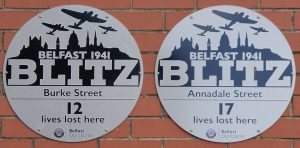
8 New Lodge – Sheridan Street
Two plaques relating to lives lost at two streets which no longer exist were placed at Sheridan Street. The CWGC List records that eleven civilians died at Burke Street, with the twelfth fatality being Stoker 1st Class Henry Brown (51) who was serving on HMS Caroline and died at 18 Burke Street with his mother, his wife, and his daughter – Mary Jane (89), Georgina (50), and Georgina (18). Thomas Mason (33), who was injured at his home in Burke Street and died at the Mater Hospital, is not included on the plaque. The CWGC List records that 18 people who lived in Annadale Street died at their homes, including Ernest William Riecken (65), the only German-born fatality of the air raids, and his wife, Mary Louisa (66) from Number 6.
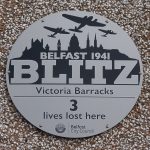
9 New Lodge – Victoria Barracks
The only Blitz plaque that relates exclusively to military fatalities was placed on the gable wall of the terrace of houses called Victoria Barracks on Carlisle Parade. These houses were built in the 1930s as married quarters for the Victoria Barracks and the first house in the terrace was destroyed during the air raid on the night of 15th/16th April and was never replaced. The NIWM Blitz Victims list records that five men from 9th Battalion East Surrey Regiment died at Victoria Barracks. Lieutenant-Colonel Richard Douglas Sutcliffe (50), Second Lieutenant Edward William Cobble (40), and Corporal John William Oliver Mason (29) died on 16th April. Private Denis Patrick James Cuffe (20), and Private Albert Joseph Skinner (20) died on 5th May. Second Lieutenant Cobble, who died whilst being transferred to Musgrave Park Hospital, is the only one of the five fatalities to be buried in Belfast, the bodies of the other four men being repatriated to Great Britain for burial.
 10 Donegall Street – St Patrick’s Church
10 Donegall Street – St Patrick’s Church
This is the only Belfast City Council Blitz plaque that had been placed inside a church in Belfast and records “130 lives lost here”. This is not true as there were no fatalities recorded for Donegall Street and St Patrick’s Church was not one of the churches to be badly damaged or destroyed in the air raids. The specified fatality figure could refer to the number of parishioners of the church who died. Alternatively, it could refer to the number of fatalities from the parish area who died, which would include people who were not Roman Catholics.
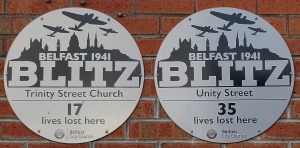 11 Carrick Hill – Unity Street and Trinity Street
11 Carrick Hill – Unity Street and Trinity Street
Two Blitz plaques have been erected on the outer wall of the Carrick Hill Community Centre, which was built on the site of the former Trinity Street Reformed (Covenanting) Presbyterian Church. There were no military fatalities recorded for the Carrick Hill area.
The Unity Street area was devastated when a parachute mine struck the spire of Holy Trinity Church of Ireland, which was located on Unity Street and faced down Trinity Street. The CWGC List records that 34 people died at Unity Street, with another person dying at Wall Street, which was immediately behind the church. The CWGC List records that 28 residents of the street died, with John McAnespie (19) dying of injuries at the Mater Hospital. As many of the houses on Unity Street and Wall Street were subsequently demolished and Holy Trinity Church was not rebuilt, the council built the Stanhope Street Playground on bomb site in 1954.
The fatality figure recorded for “Trinity Street Church” does not stand up to scrutiny as the only person recorded as dying at Trinity Street was Kathleen Duff (16) from Hanover Street who was a Typist at ARP Post 396 and was killed by falling masonry. Six other volunteers at ARP Post 396 died at Unity Street. The only resident of Trinity Street recorded as a fatality was Katherine Muldoon (32) from Number 20 who died in Unity Street and is buried in the graveyard at St Joseph’s Church, Hannahstown.
In an oral account, an ARP Warden refers to the spire of “Trinity Street Church” being hit by a parachute mine but Trinity Street Reformed Presbyterian Church did not have a spire – it was Holy Trinity Church of Ireland that was hit. In effect, the “Trinity Street Church” fatality figure relates to people who died in Unity Street and demonstrates the danger of relying on oral accounts without cross-checking against historic documents and sources.
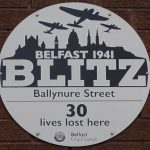
12 The Bone – Ballynure Street
The CWGC List and the NIWM List both record that 29 people died at Ballynure Street, with 26 of the fatalities being residents of the street, and there is no record of any military fatalities. Eleven people died at 4 Ballynure Street, including three members of the Thompson family from 3 Lee Street. Jeremiah and Lavinia Clarke (both 51) and six children ranging in age from 10 to 26 died along with their married daughter, Unice Thompson (19), their son-in-law, John Thompson (21), and their granddaughter, Joan Thompson (2). Only four of the eleven fatalities were identified, with the deaths of the others being presumed at a Coroner’s Enquiry on 14th June 1941. John Thompson is buried in Belfast City Cemetery and Lavinia Clarke is buried in Carnmoney Cemetery. William Clarke (15) and Cecil Clarke (12) were buried in marked coffins in the Blitz Ground at Belfast City Cemetery on 21st April 1941. Robert Clarke (26) was involved in war work at the Short & Harland aircraft factory. In total, 34 people living in the “Bally” streets in this part of Belfast died during the air raids.
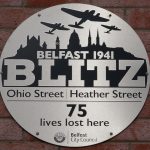
13 Woodvale – Ohio Street and Heather Street
Two identical plaques were erected one at the Welcome Evangelical Church on Heather Street and one at the junction of Ohio Street and Disraeli Street. The CWGC List records that 40 people died at Heather Street, with 37 of the fatalities being residents and the two being from nearby Disraeli Street and Montreal Street. ARP Warden James Henry Robinson (29) from Donaldson Crescent off Twaddell Avenue. The CWGC List records that 25 people died at Ohio, with 22 of the fatalities being residents of the street – two of the fatalities lived in nearby Columbia Street and one lived in Glencairn Crescent off the Ballygomartin Road. The CWGC List records that 72 people died at Heather Street, Ohio Street, and the streets with which they intersect, and that 73 residents of the same area died, three of the latter dying of injuries at hospital.
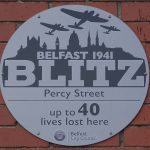
14 Shankill – Percy Street
The Blitz Plaque erected for Percy Street is another which records an approximate fatalities figure. The CWGC List records that 37 people died at Percy Street, ten of whom were not residents of the street. The CWGC List records that 29 residents of Percy Street died in the air raids, with Frederick Owens (41) dying of injuries at the Royal Victoria Hospital. One resident of Percy Street died in the first German air raid on the night of 7th/8th April. Archibald McDonald (22) from 80 Percy Street was a volunteer with the Auxiliary Fire Service and he died fighting the fire at the McCue Dick Timber Yard on Duncrue Street and is buried in Dundonald Cemetery. Four people injured at Percy Street died at the Royal Victoria Hospital, including Thomas Harvey (38) of 12 Tyne Street who died on 8th May 1941 and was buried in Belfast City Cemetery two days later. Ten people died at the Percy Street Air Raid Shelter, including two Able Seaman of the Royal Navy. George James Henry Saunders (21) from Brighton in Sussex was a crewman on HMS Skate which was moored in Belfast Harbour and is buried in a military plot at Belfast City Cemetery. Samuel Corry (26) of Joseph Street in Belfast was on home leave from HMS Quebec and died with his wife, Martha Mary (27) and their ten-month old daughter, Elizabeth. They are buried in a family plot in Belfast City Cemetery.
Conclusion
The fatality figures recorded on the BCC Blitz Plaques rarely tie in with the fatalities recorded by CWGC and NIWM but, as no names are available relating the BCC plaques, it is not possible to reconcile the figures. When I was in contact with BCC about the plaques may years ago, I was told that the council had just been given the figures. The person whose role covered the erection of the plaques moved to a new role and contact with Belfast City Council lapsed. Several plaques (e.g. Antrim Road and Greencastle) were not, as far as I am aware, ever erected. “With hindsight, it would have been better if the plaque figures had represented a combination of fatalities at each location and fatalities who lived at each location. It would also have been better if all the plaques had used “up to nn lives lost” rather than specifying an exact figure. A Freedom of Information Request has been lodged with Belfast City Council seeking details of how the figures quoted on the plaques were determined.
Author: Nigel Henderson, Researcher, History Hub Ulster

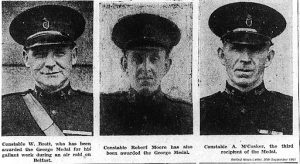
 During an air raid in May, Auxiliary Nurse Denise Forster (21) was on duty at the Ambulance Depot on the Holywood Road when it was demolished by a high explosive bomb.
During an air raid in May, Auxiliary Nurse Denise Forster (21) was on duty at the Ambulance Depot on the Holywood Road when it was demolished by a high explosive bomb. 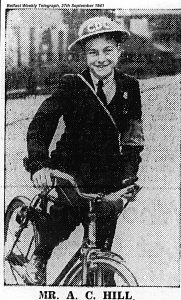 Messenger Alexander Cecil Hill (17), an office assistant from Convention Street, received the BEM. Although severely shaken by an explosion nearby, Alexander directed traffic at a main road whilst bombs were falling nearby. Later, whilst delivering an urgent message to the Report Centre, he was blown off his bicycle by explosions twice but each time he remounted and delivered the message.
Messenger Alexander Cecil Hill (17), an office assistant from Convention Street, received the BEM. Although severely shaken by an explosion nearby, Alexander directed traffic at a main road whilst bombs were falling nearby. Later, whilst delivering an urgent message to the Report Centre, he was blown off his bicycle by explosions twice but each time he remounted and delivered the message.  BEMs were awarded to Bomb Identification Officer William John Ford (51) and Messenger William Ernest Bennett (15) of Wandsworth Gardens for rescue work at Cliftonville Road where bombs had destroyed a number of houses and fractured a gas main. Ford and Bennett burrowed six yards through rubble to bring an elderly man to safety and then they rescued two stranded women from a house that was in danger of collapse. Bombs were falling as they worked and both suffered from the effects of inhaling coal gas. William Bennet later joined the National Fire Service.
BEMs were awarded to Bomb Identification Officer William John Ford (51) and Messenger William Ernest Bennett (15) of Wandsworth Gardens for rescue work at Cliftonville Road where bombs had destroyed a number of houses and fractured a gas main. Ford and Bennett burrowed six yards through rubble to bring an elderly man to safety and then they rescued two stranded women from a house that was in danger of collapse. Bombs were falling as they worked and both suffered from the effects of inhaling coal gas. William Bennet later joined the National Fire Service.
 Shrove Tuesday 1945, Allied planes drop bombs on Dresden, killing thousands of people, most of them believed to be civilians and refugees.
Shrove Tuesday 1945, Allied planes drop bombs on Dresden, killing thousands of people, most of them believed to be civilians and refugees.